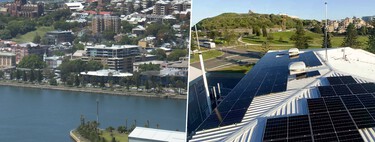The fluctuations in oil prices in recent days were not unexpected, given that geopolitical conflicts in the world are far from being resolved. In addition, the deadline for meeting energy targets is approaching and new oil fields show that There are still unexploited nooks and cranniesFaced with such a scenario, Saudi Arabia has set its sights on solar panels.
Saudi Arabia imported 9 GW of solar panels. By 2022, Saudi Arabia was entirely dependent on fossil fuels (99.8%) for its electricity generation, far from its goal of relying 50% on renewables by 2030.
So far this year He wanted to turn around Saudi Arabia has responded to this situation and has purchased a total of 9.7 GW of solar panels from China, the largest exporter of these systems. This significant increase seems to indicate that the Saudi country wants to enter the global solar market. In addition to meeting the objectives set within its framework, Vision 2030 and now has approved projects to be operational by 2027.
Vision 2030. It is a project from Saudi Arabia that proposes a diversification of its economy to stop depending on oil entirely. This strategy seeks to achieve a balance in cutting-edge sectors such as tourism, technology and renewable energy. The main objective is to find new ways to increase profits and generate half of its electricity from renewable sources by 2030.
The case of Pakistan. Saudi Arabia is not the only player in the game, as Pakistan is also getting into the solar market. its renewable energy It is dominated by hydroelectric power, which occupies 24%, and also has small wind and solar installations. The latter gained momentum in 2010 following the energy crisis, where they began installing solar panels to find a solution to energy problems. In addition, they have just imported 12.5 GW of solar panels, thus boosting the need for on-demand.
The rise of solar. The global energy landscape is set to change in a few years. Scientists have suggested the learning effect: this phenomenon explains why the cost reduction of solar panels is due to economies of scale, while technological efficiency is also improving. Furthermore, in a world that is decarbonising, not only do countries want to meet climate targets but they also see a strategic opportunity in investing in what will be the energy of the future.
Outstanding debts. Although many countries have set out to advance in the renewable energy sector, there are still some that have this issue pending. As for those that produce the most emissions and are lagging behind, we find Indonesia and Russia. On the one hand, Indonesia It presents a great dependence to fossil fuels in its electricity and although its emissions are almost below the world average, its share of renewables does not reach 0.2%. On the other hand, Russia consumes 64% of its fossil fuel-based electricity generation, as well as being the fourth largest emitter in the electricity sector and with emissions more than double the world’s. Its commitment to renewables is only 0.45%.
Meanwhile, other polluting countries such as South Africa and the United Arab Emirates show a surge in solar markets to achieve decarbonisation.
Global solar image in 2024. By the end of this year, global installed solar capacity is expected to exceed 593 GW, thanks to large investments and falling costs in solar panels. This sector is led by China, while countries such as the United States and India are seeing increases in their solar capacity. New players in the solar market, such as Saudi Arabia, show how renewables are positioning themselves within the economy and the future will depend on this new panorama.
Image | Pixabay and Unsplash
Xataka | Germany is approaching the utopia of self-consumption in cities: a million solar panels hanging from balconies











![[Img #73891]](https://thelatestnews.world/wp-content/uploads/2024/09/Chatting-with-a-chatbot-to-alleviate-conspiracy-fears-300x200.jpg)
Add Comment